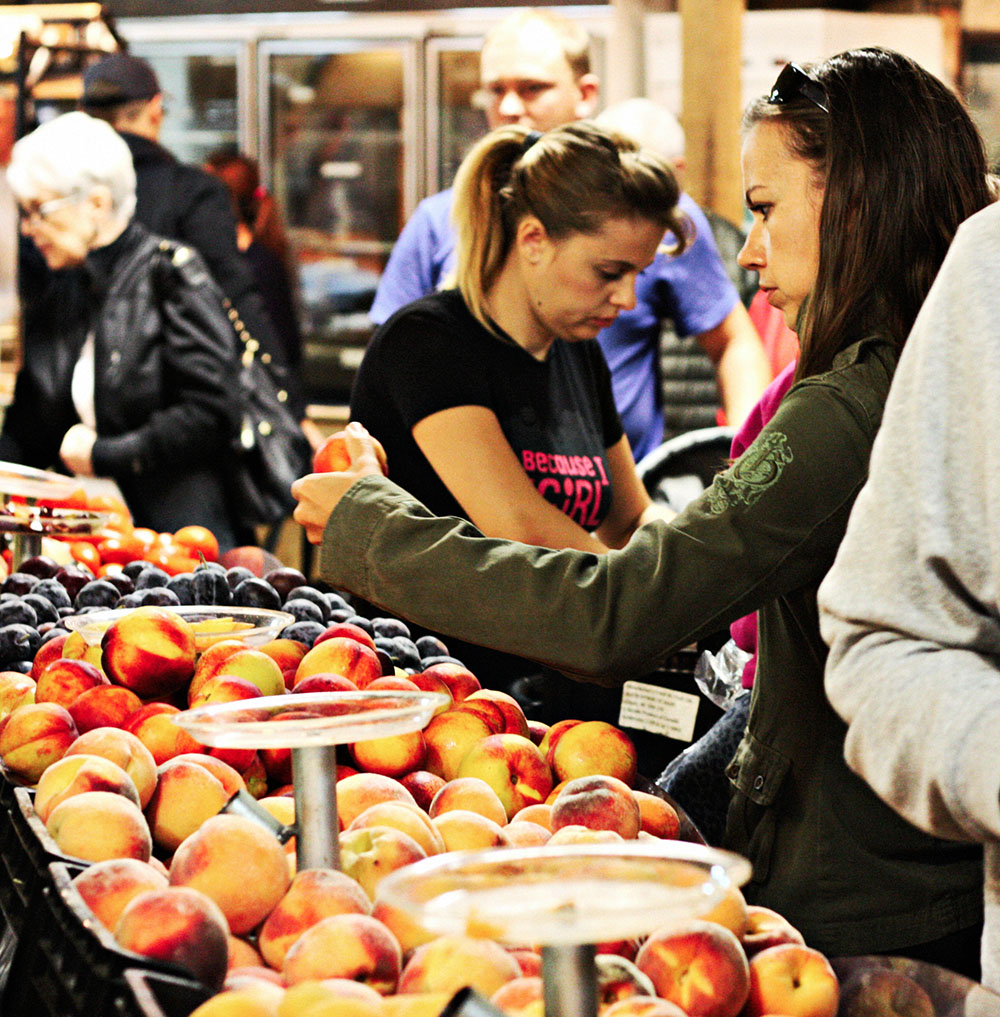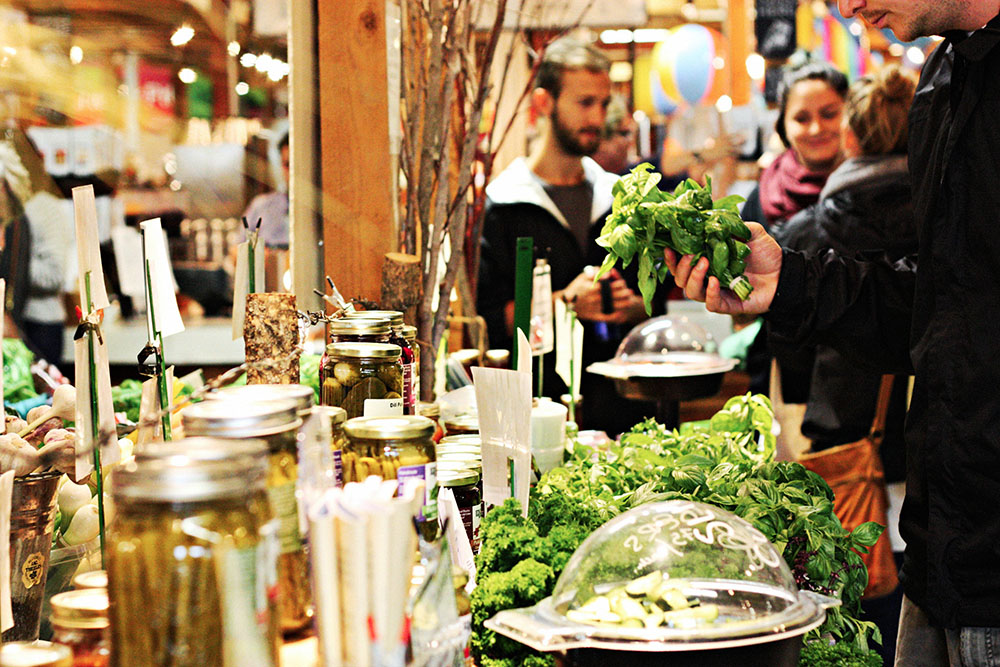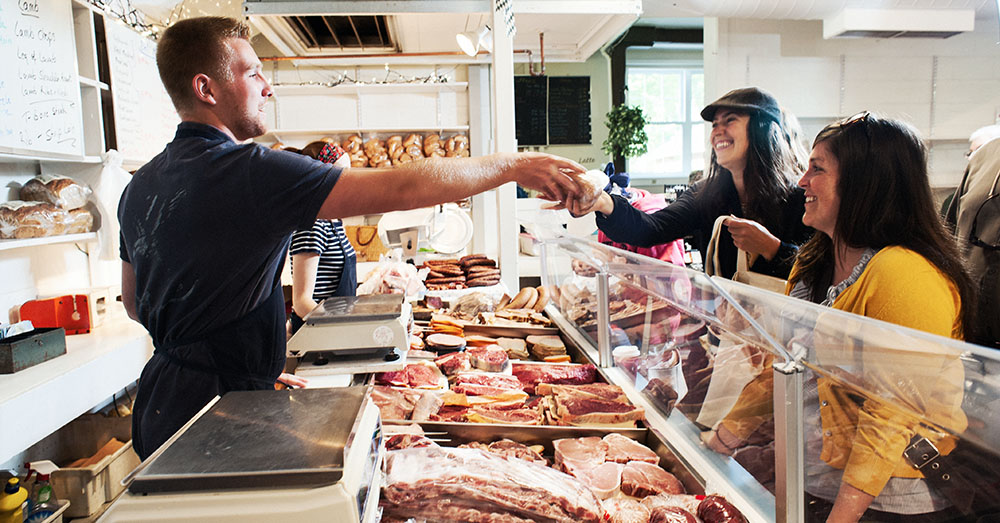
Farm-to-table is everywhere — in our restaurants, at our grocery stores. It embodies everything from food traceability to buying local. But it also means exactly what it says: food leaving farms, making a pit stop in the kitchen to be transformed into something delicious and then appearing on the table for your gastronomic pleasure.
Thing is, farm-to-table isn’t just for restaurants anymore. I can take it home with me and create something of my own. To do this, I stuff my reusable grocery bags in my purse and head to the farmers’ market.
The concept of a market where farmers and other craftspeople gather to sell their wares directly to consumers has always been present wherever communities existed. It was only in the early 1900s that grocery stores and general stores started to take over. However, these larger stores placed more emphasis on the shopping experience, deviating further and further away from local production and merchants.
Which brings us to today’s market and the reason why farm-to-table exists in the first place. For reasons of convenience, we went too global to meet our supply needs. We left our farmers, growers, producers and craftspeople behind. Right around the same time as the farm-to-table social movement started, farmers’ markets started seeing more consumer demand: people were coming out of their convenience-first daze, realizing that shopping local not only places better-quality ingredients in their kitchens, but also supports the local economy.
And sometimes, these markets are open year-round, consistently offering products from a wide variety of vendors. The Calgary Farmers’ Market, for example, is open every Thursday through Sunday, with around 80 vendors hawking their wares. “Generally, they’re the same vendors all year,” says Leilani Olynik, the Market’s Marketing Coordinator. “We have a few seasonal vendors that come in the spring … two Hutterite colonies … and then we have one, she grows herbs. She’s not a greenhouse grower; she can’t grow through the winter. So, she’s only here in the spring and summer.”
On the east coast, it’s a similar story for the Boyce Farmers’ Market in Fredericton, New Brunswick. “At any given time, we can have as many as 200 [vendors],” says Market Co-ordinator Leslie Morrell. “And in the summer and fall months, over 200.” The Boyce Farmers’ Market is open every Saturday, with Morrell overseeing the vast array of vendors.
“My role here is to run the market: that includes taking care of all the vendors, where the casuals will be [since] reserved vendors have the same spot each Saturday,” Morrell explains. “Casuals come on a seasonal basis or some come each Saturday also. Christmas tree farmers, for example, only come November to December.”
Seasonality is one challenge that farmers’ markets face in competing with grocery stores. “There are produce patterns based on seasonality, but as no two years are ever alike, there is some flexibility required for when things will hit our shelves,” says Olynik, a sentiment that is shared by Morrell.
“It would depend on our seasons here and how soon the farmers get their crops in, so of course everything is weather dependent,” says Morrell. “We’re at the mercy of Mother Nature.”
When I spoke to Morrell and Olynik in April, they were only able to provide a loose idea of what might be available year round. Olynik’s list, created based on past seasons at the Calgary Farmers’ Market included apples, apricots, artichokes, beans, blueberries, broccoli, cabbage, carrots, cauliflower, celery, cherries, corn, cucumbers, peas, potatoes, rhubarb, strawberries, spinach, tomatoes, raspberries and zucchini, with blackberries, onions, peaches, pears, plums, Swiss chard and winter squash joining the line up in August. (You can visit the Calgary Farmers’ Market’s website for an up-to-date “What’s in Season” guide).
Morrell was predicting that the Boyce Farmers’ Market would have an abundance of fresh-picked blueberries and raspberries. “The apples come in later, usually more into the end of August also. Corn comes usually in August … again depending on when we get the crops in,” she recounts. She also mentioned that squash may start coming in as early as August, though squash and pumpkins usually start making an appearance in September and October, as a matter of supply and demand. “That’s when people are looking for them. A farmer is not going to bring a pumpkin to market to be for a jack-o’-lantern in August, because of course it’s going to rot by October. So they’ll let them get as big as they possibly can. It depends on the time of year and what people want them for. Now your pie pumpkins will start coming in as soon as they’re ready.”
This seasonal nature of farmers’ markets may deter you from visiting. However, many market vendors have a storage system so they can offer you farm-fresh foods all year.
“You would see your full line of farmer produce, like lettuce and carrots and turnips and … beans and peas and everything here,” Morrell assures me. “For carrots, parsnips, turnips and everything like that, we have some vendors that have cold storage.”
Cold storage is also used by vendors at farmers’ markets across the country. Olynik mentioned that the Calgary Farmers’ Market works with BC Tree Fruits to supply apples right through until April.
“Any of the BC apples you see are usually held in the BC Tree Fruits refrigeration unit and then they’re brought to us. They’re apples that were picked in the fall that … our vendors can access.”
Another way that vendors get over the seasonality hurdle is through greenhouse growing. When you visit the Calgary Farmers’ Market “What’s in Season” webpage, there are a few items with a (GH) beside them — this denotes those items that are grown in a greenhouse.
The third way farmers’ markets are able to provide produce year-round is by shipping in products from outside of the region. “Unfortunately, in the winter months, there are a couple of our produce vendors, especially our organic vendor . . . they have to ship items that aren’t technically local,” admits Olynik. “They’ll ship items from Washington or California. They’re the only options we have, kind of like a grocery store.”
“We have two vendors who are grandfathered in that can buy from other producers and bring in for the market,” says Morrell. “They’ll bring blueberries and raspberries in, and they’ll bring them as close as they can to New Brunswick because sometimes they have to come from Quebec.”
This does stretch the concept of local a little bit, but it is necessary if the markets are going to maintain a year-round selection. Ultimately, and most importantly, allowing the farmers to out-source is still in line with the spirit of a farmers’ market — supporting local farmers and local commerce.
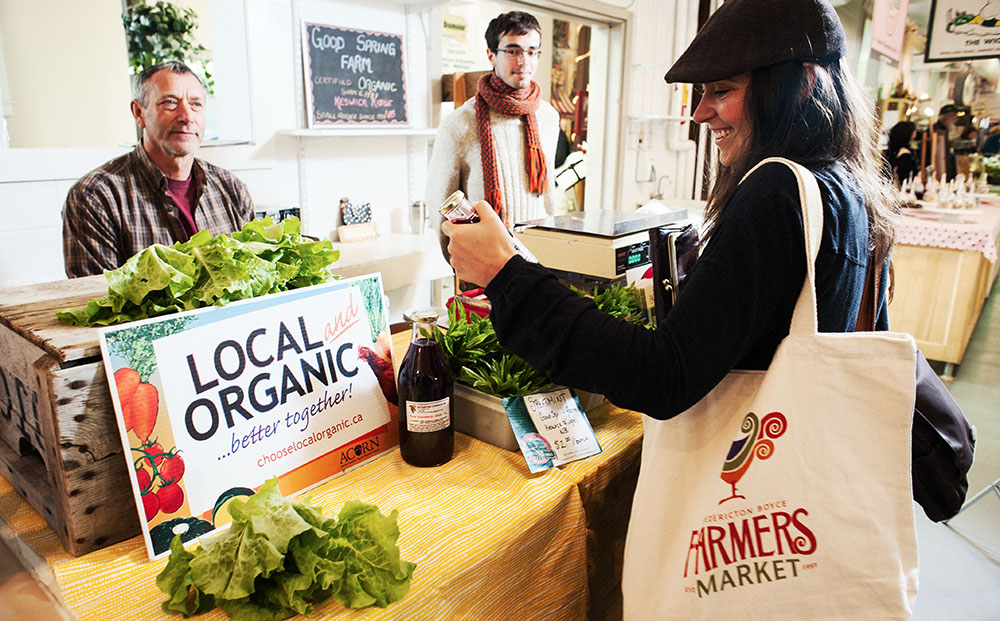
“Our vendors want to, as much as they can, provide local items, but at the same time, they don’t want to turn away customers because they don’t have, say, bananas. So, they have to walk that line between maintaining local items and giving the customer what they want and need,” explains Olynik.
But produce and growers aren’t the only types of vendors you’ll find at a Farmers’ Market. There are also a variety of craftspeople, artisans, preservers and more. Staying open year-round benefits these local businesspeople as much as it does local farmers.
“We’ve got meat vendors and bakeries, artisans, olive oil, charcuterie and meats, and bath and body products,” mentions Olynik. “We’ve got everything under the sun for people so they can do one-stop shopping, which is nice, and they can shop as local as they can all year-round. If we only offered root vegetables all year-round, then it would be very difficult for them to stay afloat in the winter months.”
Visiting a farmers’ market can be intimidating, especially when you know there will be 100 to 200 vendors selling a variety of items. I asked Morrell and Olynik what you should do when you first visit, whether you have a purpose or are just browsing.
“Don’t buy anything until you’ve looked around the whole market first and then start doing your shopping,” Morrell advises. “You might find something somewhere that’s maybe a little bit cheaper a couple stalls down or a little closer to what you’re looking for.”
Olynik agrees with Morrell, adding that you should talk to the farmers. “We’re more than a supermarket,” she states. “Talk to your farmers, producers, artisans. The beauty of shopping at a farmers’ market, for me, is in the relationships you build and the connection you have with your food. So many people don’t know where their food comes from, or what path it took to get to your plate. Being able to shake the hand of the person who made, baked or grew your food is special.”
“The beauty of shopping at a farmers’ market, for me, is in the relationships you build and the connection you have with your food.”
Leilani Olynik
That sense of community is cultivated and developed at every farmers’ market across the country — it is the spirit of the market. You meet the faces behind the food you’re about to consume. You can also ask questions, learn how to tell what’s fresh and what’s not. You support the small businesses that feed us by buying from them directly rather than through a faceless third party. You build your own confidence when it comes to picking out the best produce, so when you do have to visit a grocery store, you’ll be able to find tasty ingredients.
And, most importantly, you’re buying local.
“The money that’s spent here stays in the community,” Morrell points out. “You know it’s not going to big business or CEOs, or anything like that; it’s going to small vendors, small businesspeople who are trying to make a living. Farmers and craftspeople and bakers.”
“Buying local keeps the local economy strong and builds a sense of community by supporting one another,” adds Olynik. And that is why farmers’ markets are our biggest tool for supporting the farm-to-table movement, and bringing home farm-fresh ingredients for our own, personal version of farm-to-table.
Try these two farm-to-table recipes from our Mav Chefs
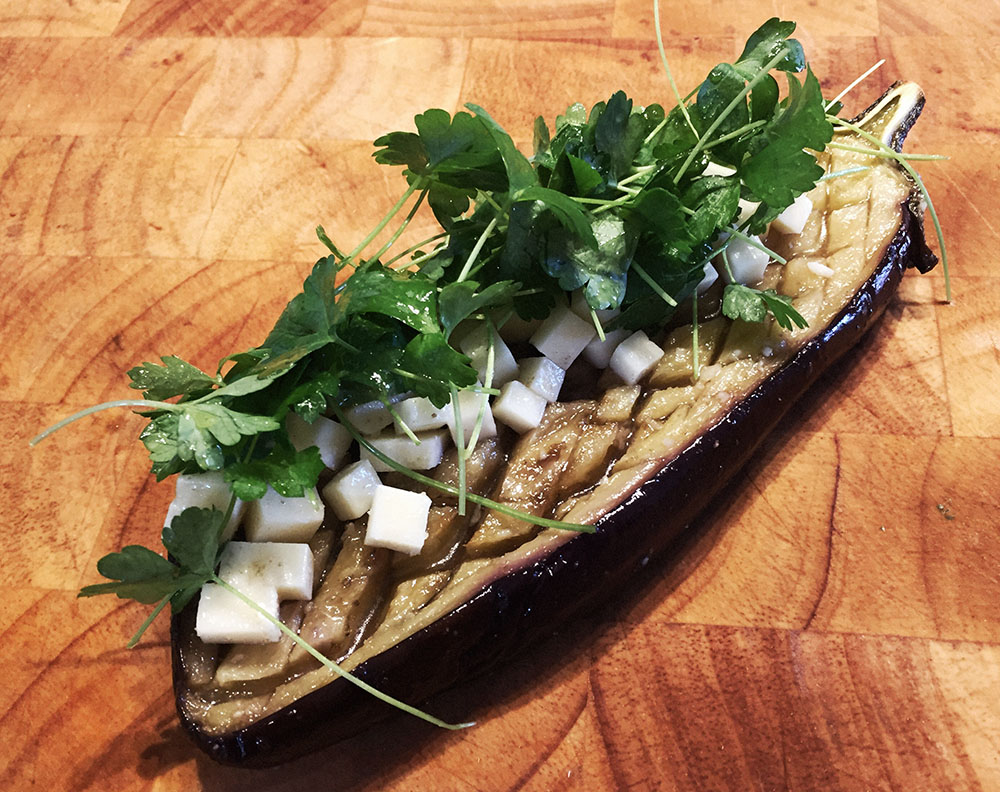
marinated gull valley eggplant
By Chef John Michael MacNeil, Calgary, Alberta, Mav Chef 2014
“The two markets that I really like to go to are the Cross Roads Market and Calgary Farmers’ Market. Both markets have different products and different vibes. One producer I love is Gull Valley Green Houses. They have really amazing tomatoes, eggplants and peppers, as well some micro-greens.
“For this recipe, choose firm, green-top, shiny-skinned eggplants — these are young, and at their best. I generally just go by the feel test: it should feel like a melon and have an airy-weight feel to them. If it feels like a soft Brie, the eggplant is too soft.
“If you don’t like chèvre, a young Spanish Manchego works great too.”
2 eggplants
1 cup olive oil
1 tbsp salt
Marinade (recipe follows)
Fresh parsley, chopped
Chèvre
Using a sharp knife, slice eggplant in half from the bottom to the top. Score crosshatches into the eggplant (these will help the eggplant cook evenly by allowing the olive oil to absorb right through).
Slowly drizzle/pour the olive oil over the eggplant until all of it is absorbed. Season with salt (you can add more than the suggested amount; I like a lot of salt).
Roast in the oven at 375°F for approximately 30 to 45 minutes, depending on the size of the eggplants. They should feel soft, but remain a little firm. Let rest for 2 to 3 minutes, then spoon on the marinade, then let cool to room temperature.
Top with parsley, more olive oil and a creamy soft cheese, like chèvre.
marinade
1 cup white balsamic vinegar
1/4 cup white sugar
1 tbsp ground cumin
1 tbsp chopped garlic
Combine all ingredients in a bowl. Whisk together until sugar is mostly dissolved.
kale and squash salad
Serves 2
By Chef Jakob Lutes, Port City Royal, Saint John, New Brunswick, Mav Chef 2016
“The farmers’ markets I work with most are the Boyce Farmers’ Market in Fredericton, and the Kingston Farmers Market. These two markets have the best selection of unique vendors and suppliers.
“When selecting kale, make sure the leaves are vibrant looking with little to no yellowing. With varieties such as curly kale, make sure the curls are nice and tight. Kale harvested early in the season will be more tender. While kale picked later in the season, especially after the frost comes, will be heartier and a bit sweeter.
“When selecting squash, ensure there are no signs of rot or bruising, especially around the stem. I often find the difference between a good squash and a great squash is in the person who grew it. So take your time finding the right supplier.”
1 large bunch kale
1 small buttercup or kabocha squash
1/2 cup cooked oat groats
1-2 tbsp Secret Sauce #1 (recipe follows)
2 tbsp butter
Preheat the oven to 350°F. Carefully cut the squash in half. We like to use a cleaver and a rubber mallet. With a spoon, scrape and remove the seeds and “guts.” Set the squash face up onto a sheet pan and place in the hot oven.
Cook the squash for 30 to 45 minutes, or until the flesh is well cooked and soft. Allow the squash to cool at room temperature. With a small spoon, scoop out small chunks of flesh from the cooked squash. Set aside 1 cup of squash.
Separate the kale leaves from the stems by grasping the bottom of each stem and pulling your other hand up to the tip. Either cut or tear the destemmed kale into the desired size. We prefer pieces the size of a toonie.
Over medium-high heat, melt the butter in a large frying pan. When the butter begins to bubble and brown, add the kale pieces and sauté. Continue to cook and sauté for approximately 2 to 3 minutes. If the pan dries out, add a small knob of butter to prevent the leaves from scorching. We cook our kale until it begins to brown and faintly char.
Add the squash and oats and continue to sauté for another minute. At this point, if the salad begins to dry out, add a tablespoon of water to the pan. Finally add the Secret Sauce. This acts as the seasoning, so add enough to suit your personal taste. Sauté and serve.
Secret Sauce #1
180 g malt vinegar
42 g cured and smoked smelt
35 g white vinegar
20 g shallot, thinly sliced
20 g fancy molasses
10 g blackstrap molasses
10 g garlic, thinly sliced
10 g white sugar
10 g celery salt
8 g fresh hot pepper, seeds removed
4 g black pepper
100 g olive oil
Place all of the ingredients except the olive oil into a blender. Blend on low and slowly increase the speed to high. One you have a smooth and uniform purée, steadily pour the olive oil into the blender to emulsify the sauce.

